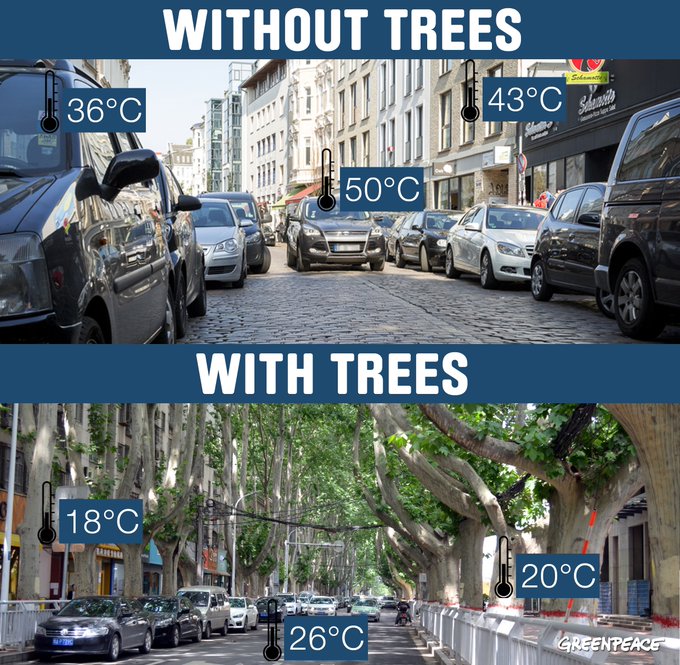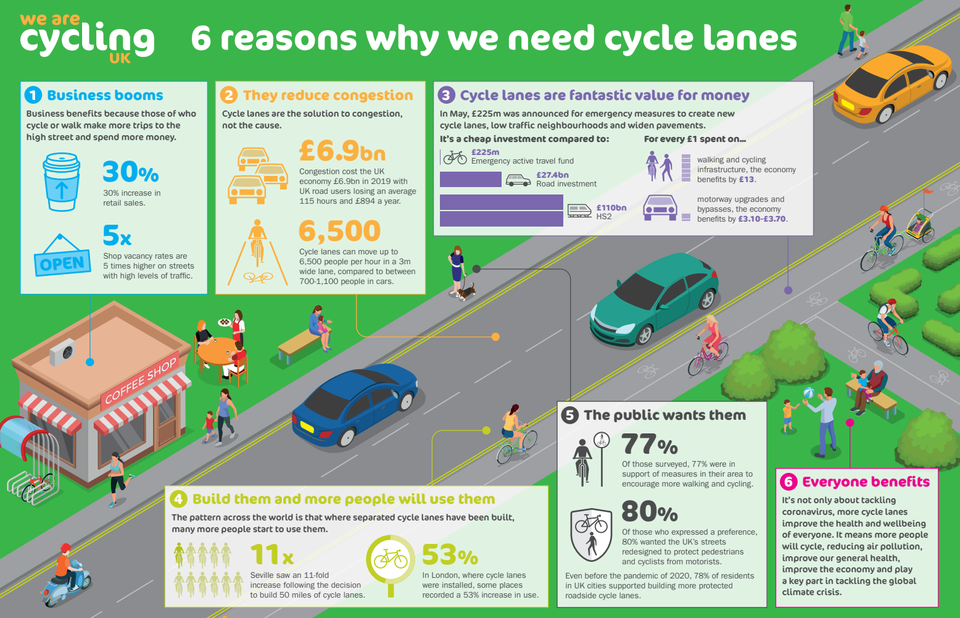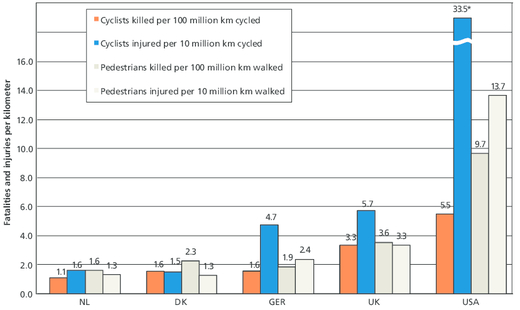What are the benefits of this?
People are happier, people are healthier. You get to save money. Stuff are more accessible now for children, senior citizen, people who couldn’t drive, people can’t afford to own a car. Air gets cleaner because there’s less pollution from cars. Local businesses improve. There are less traffic to do deal with.
Resources
Dutch Cycling - YouTube - BicycleDutch
https://www.youtube.com/watch?v=ayPDlDi9Ug4
This video sums up all that is good with cycling in just 5 minutes.
Individual and social costs of car travel more than six times those of cycling
https://www.reddit.com/r/fuckcars/comments/rmoq84/societal_cost_of_driving_vs_cycling/
Here is a study from Copenhagen by the Danish Ministry of Transport. The gist of the article is that we shouldn’t think about the cost of a bike infrastructure but rather comparing them with a car infrastructure.
The results found that cars cost 0.50 €/km compared to bicycle’s 0.08 €/km per individual. However, if taking consideration of the costs and benefits of bicycle infrastructure, one kilometre by car costs society €0.15, whereas society earns €0.16 for every kilometre cycled.
The cost of cars comes from air pollution, climate change, noise, congestion, road deterioration, time cost, accident cost, health, vehicle operating costs, and tourism.
Sensationserfolg Pop-up-Radweg Kantstraße in Berlin: Untersuchung der Deutschen Umwelthilfe belegt Verdreifachung des Radverkehrs und Verbesserung der Luftqualität – Deutsche Umwelthilfe e.V.
https://www.reddit.com/r/fuckcars/comments/ra8i0j/sensational_success_of_the_kantstrasse_popup/
This article is in German. But it is about how air quality has improved and vehicle traffic has dropped.
Sensational success of the Kantstrasse pop-up cycle path in Berlin: Investigation by Deutsche Umwelthilfe shows that cycle traffic has tripled and air quality has improved. From 1,500 to more than 5,100 bicycles per day after the introduction of the pop-up cycle path, vehicle traffic drops by 22%
Utrecht: Planning for People & Bikes, Not for Cars - YouTube - Streetfilms
https://www.youtube.com/watch?v=Boi0XEm9-4E
At 8:53, cities are quieter.
At 12:28, children are free to go anywhere they like.
Groningen: The World’s Cycling City - YouTube - Streetfilms
https://www.youtube.com/watch?v=fv38J7SKH_g
At 4:20, bicycles are cheaper form of transportation.
At 7:24, you have to build a network of bike paths in order for it be to successful.
At 11:08, it is very quiet.
Arriving at school on a bicycle (Netherlands) [298] - YouTube - BicycleDutch
https://www.youtube.com/watch?v=8NUgB_xkIvU
Here is a video where kids go to school unsupervised and there is plenty of space for everyone to park their bikes.
Cycling to school; Culemborg (Netherlands) [149] - YouTube - BicycleDutch
https://www.youtube.com/watch?v=OrQ-d2PBUto
- https://reddit.com/r/fuckcars/comments/urp5bo/children_have_no_freedom_in_car_dependency_we/i8yi1oa/
A video of kids cycling to school without needing any cars to send them. No traffic, no fuss.
A normal morning commute in Perth : perth
https://www.reddit.com/r/perth/comments/rcch74/a_normal_morning_commute_in_perth/
https://www.reddit.com/r/fuckcars/comments/rcg7ac/billiondollar_freeway_vs_twolane_bike_lane/
Here is a video of a couple of people riding on a bike path while cars are stuck in traffic. (Not sure where I want to put this yet)
Impacts of 2020 Low Traffic Neighbourhoods in London on Road Traffic Injuries | Published in Findings
- https://www.ft.com/content/56929d0a-2375-40a1-872c-b7fb94d9003f
- https://www.reddit.com/r/AbolishCars/comments/rdwlad/car_users_dont_have_an_inalienable_right_to/
70% reduction in injury numbers.
This research indicated that inside the LTN areas there was approximately a 70% reduction in absolute injury numbers and also approximately a 70% reduction in risk per trip for walking, cycling and car travel alike.
association between active commuting and incident cardiovascular disease, cancer and mortality study
https://www.bmj.com/content/bmj/357/bmj.j1456.full.pdf
- Why Mandating Bicycle Helmets is a Bad Idea - YouTube - tehsiewdai
- https://reddit.com/r/fuckcars/comments/t0edey/controversial_now_is_the_best_time_than_ever_to/hyc0iql/
From the conclusion in the paper,
Cycle commuting was associated with a lower risk of CVD, cancer, and all cause mortality. Walking commuting was associated with a lower risk of CVD independent of major measured confounding factors. Initiatives to encourage and support active commuting could reduce risk of death and the burden of important chronic conditions.
Cycling is the best:
commuting by cycle and by mixed mode including cycling were associated with lower risk of all cause mortality
It reduces cancer by 45% and heart diseases by 46%. You can see it at 4:03 in the referrer video.
How to Build a City Around Bikes, Fast - YouTube - Bloomberg Quicktake
https://www.youtube.com/watch?v=h-I6HFQXquU
It costs $20 million to build a 80km cycle nenetwork. When you build 1km of a highway, you build hundreds of kilometers of cycling lanes.
Nijmegen: The City That Tamed Cars So People Can Walk & Bike Where They Please - YouTube - Streetfilms
https://www.youtube.com/watch?v=gjLZv3Y0CWM
At 6:05, the people interviewed all said that the city is silent. You don’t hear any traffic.
8 to 80, people of all ages cycling in the Netherlands [153] - YouTube - BicycleDutch
https://www.youtube.com/watch?v=swqaAIkGtpA
At 3:31, kids are able to be more independent.
Bicycling Can Sharpen Your Thinking and Improve Your Mood | Psychology Today
-
https://www.reddit.com/r/fuckcars/comments/s01dsh/could_car_dependence_make_us_more_anxious_as_a/
-
Lowering blood pressure, improving cholesterol levels, managing their weight and reducing their risk of developing heart disease and type 2 diabetes.
-
Brain scans showed that practicing pedaling on a regular basis increased the integrity of white matter fiber tracts in both healthy and schizophrenic brains.
-
Prevent or relieve stress, anxiety and depression.
Property values ‘thrive’ near transit, study finds | Smart Cities Dive
https://www.smartcitiesdive.com/news/property-values-thrive-near-transit-study-finds/564982/
10 years ago, places that are near to amenities were the ones that drive up property value. But now, it’s places that are near transit.
Public Transportation Facts - American Public Transportation Association
https://www.apta.com/news-publications/public-transportation-facts/
Lots of good facts in here that advocates for public transportation. Interesting stuff like:
- Every $1 invested in public transportation generates $5 in economic returns.
- Traveling by public transportation is 10 times safer per mile than traveling by automobile.
- Communities that invest in public transit reduce the nation’s carbon emissions by 63 million metric tons annually.
Banning cars would lead to a more efficient lifestyle
http://towardzeroimpact.net/CCC/CCC-benefits.php#section-efficiency
Cycling - the exercise for positive mental health | MensLine Australia
https://mensline.org.au/mens-mental-health/cycling-the-exercise-for-positive-mental-health/
All exercise is good but cycling is the best because it combines physical activity with being outdoors.
How good is cycling for the environment? Co2 emissions of transport ranked - BikeRadar
https://www.bikeradar.com/features/long-reads/cycling-environmental-impact/
- https://reddit.com/r/fuckcars/comments/tg0exa/how_funny_and_ironic_rail_service_has_one_of_the/i0zilp1/
- https://reddit.com/r/fuckcars/comments/tywdou/8_min_by_car_or_98_by_public_transit_i_want_to/i3w9blg/
Cycling has the lowest carbon footprint of any mode of personal transport, even when compared to walking.
If cycling’s popularity in Britain increased six-fold (equivalent to returning to 1940s levels) and all this pedalling replaced driving, this could make a net reduction of 7.7-million tons of CO2 annually, equivalent to 6% of the UK’s transport emissions
People More Likely to Reach 100 If They Live in Walkable Neighborhoods
https://www.insider.com/living-in-walkable-neighborhood-could-help-you-live-100-study-2020-6
You are more likely to live longer if you live in walkable neighborhoods. People can exercise, socialize and amenities are more easily accessible.
What’s More Efficient Than a Person on a Bike? | Bike New York
https://www.bike.nyc/blog/news/how-cyclists-beat-every-other-moving-creature-and-machine/
There is nothing more efficient than a human being on a bike.
People with disabilities and use of public transit: The role of neighborhood walkability - ScienceDirect
https://www.sciencedirect.com/science/article/abs/pii/S0966692322000424
This is a study on how the disabled view public transit. From the study,
First, disabled individuals tend to have more frequencies of transit use than their non-disabled counterparts. Second, individuals living in walkable neighborhoods are more likely to use transit in general. Third, after controlling for various other factors, non-worker disabled individuals are less likely to use public transit than others. Lastly, higher levels of walkability are positively associated with transit use of disabled individuals than others
Greenpeace Belgium Twitter
https://mobile.twitter.com/greenpeace_be/status/1027490895359340545

Building infrastructure for cars results in a higher temperature. When you can replace those infrastructure with trees, things cool down.
Separated Bike Lanes Means Safer Streets, Study Says – Streetsblog USA
After analyzing traffic crash data over a 13-year period in areas with separated bike lanes on city streets, researches estimated that having a protected bike facility in a city would result in 44 percent fewer deaths and 50 percent fewer serous injuries than an average city.
Superblocks: Barcelona’s car-free zones could extend lives and boost mental health
From the article:
The research suggests this would significantly improve air quality and noise levels on the car-free streets: ambient levels of nitrogen dioxide (NO₂) would be reduced by a quarter, bringing levels in line with recommendations from the World Health Organisation (WHO).
The plan is also expected to generate significant health benefits for residents. The study estimates that as many as 667 premature deaths from air pollution, noise and heat could be prevented each year. More green spaces will encourage people to get outdoors and lead a more active lifestyle.
This, in turn, helps to reduce obesity and diabetes and ease pressure on health services. The researchers claim that residents of Barcelona could expect to live an extra 200 days thanks to the cumulative health benefits, if the idea is rolled out across the city.
Six reasons to build cycle lanes | Cycling UK
https://www.cyclinguk.org/article/six-reasons-build-cycle-lanes
Here is an infographic on why we need cycle lanes.

Who else benefits from the Dutch cycling infrastructure [231] - YouTube - BicycleDutch
https://www.youtube.com/watch?v=xSGx3HSjKDo
- https://bicycledutch.wordpress.com/2012/12/06/who-else-benefits-from-the-dutch-cycling-infrastructure/
- https://reddit.com/r/fuckcars/comments/tzzt33/not_cars_but_still_these_barriers_designed_to/i4655ex/
- https://www.reddit.com/r/fuckcars/comments/u5dg2k/serious_i_am_disabled_what_are_some_ways_i_could/i5328qp/
- https://reddit.com/r/fuckcars/comments/v8ftqo/american_infrastructure_is_inhumane_winstonsalem/ibr0xpc/
Able bodied people, senior citizens, children, disabled people are all able to use the great cycling infrastructure in the Netherlands. These cycling paths also allow mobility scooters to use them. It’s very safe because they’re protected from the car lanes.
Why cities with high bicycling rates are safer for all road users - ScienceDirect
https://www.sciencedirect.com/science/article/abs/pii/S2214140518301488?via%3Dihub
Despite bicycling being considered ten times more dangerous than driving, the evidence suggests that high-bicycling-mode-share cities are not only safer for bicyclists but for all road users.
This is because:
Better safety outcomes are instead associated with a greater prevalence of bike facilities – particularly protected and separated bike facilities – at the block group level and, more strongly so, across the overall city. Higher intersection density, which typically corresponds to more compact and lower-speed built environments, was strongly associated with better road safety outcomes for all road users
Benefits of cycling to work outweigh risks | Cycling Weekly
https://www.cyclingweekly.com/news/latest-news/benefits-of-cycling-to-work-outweigh-risks-451480
Despite the added risks when cycling to work, it is safer in terms of health wise. What this means is that if we can lower these risks by providing safe cycling infrastructure, it’s a win-win for everyone.
Why the health benefits of cycling to work outweigh the risk of injury | New Scientist
This article supports the previous entry.
(PDF) Do the Health Benefits of Cycling Outweigh the Risks?
This article supports the two previous entries.
(PDF) Walking and cycling in Western Europe and the United States: Trends, policies, and lessons

When there is adequate infrastructure for pedestrians and cyclists, it is safer for everyone.
Anatomy of a Protected Bike Lane: Infographic shows overwhelming benefits of good street design | Broken Sidewalk
https://brokensidewalk.com/2016/anatomy-protected-bike-lane/
Statistics on how protected bike lanes make safer streets for everyone.
According to PeopleForBikes’s research, installing a Protected Bike Lane on a street cuts injury risk to bikes by 28 percent.
Bicycles cause no damage to road surfaces - Ferrovial’s blog
https://blog.ferrovial.com/en/2018/04/bicycles-cause-no-damage-to-road-surfaces/
-
https://reddit.com/r/fuckcars/comments/uom97t/puddles_reveals_damage_caused_by_cars_to_the/i8hw88i/
-
Bicycles cause no damage to road surfaces
-
Bicycles don’t pollute as they move
Healthy Streets and how the Dutch build them - Mobycon
https://mobycon.com/updates/healthy-streets-and-how-the-dutch-build-them/
Dutch streets are made for people in mind where cars are guests.
True mass cycling: Gone to the Park. Dutch teenagers' & childrens' social lives depend on bicycles - YouTube - David Hembrow
https://www.youtube.com/watch?v=RNmGdAQZwb4
- https://reddit.com/r/fuckcars/comments/urp5bo/children_have_no_freedom_in_car_dependency_we/i8yi1oa/
Japan encourages parents to let kids walk to school solo - YouTube - CBS Mornings
- https://reddit.com/r/fuckcars/comments/urp5bo/children_have_no_freedom_in_car_dependency_we/i8yi1oa/
When you build safe infrastructure in Japan, 7 year old kids can go to school unsupervised.